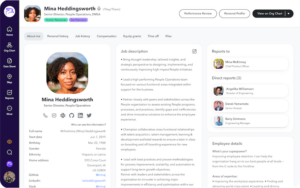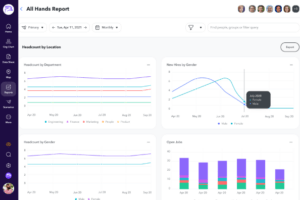
The Wizard of Oz is a classic film, yet many people forget how scary it is. For kids, it’s the flying monkeys that cause nightmares. For adults it’s…ok, let’s just admit the monkeys are terrifying no matter what age you are.
But you also feel deceived, right along with Dorothy and her crew, when you realize that the Great and Powerful Oz himself is one giant ruse who simply leads through fear and deception. Behind the literal smoke and mirrors is just a man giving bad advice without any accountability.
Maybe this is actually the thing you need to fear: an unapproachable leader who isn’t invested in your wellbeing.
The alternative is a leader who is transparent and makes data-driven decisions. This is the kind of executive or manager employees want – one who shares information so that the team can feel prepared, supported, and respected no matter what arises.
Embedding transparency into your leadership style and processes will not only benefit your employees, but your operation as a whole.
Trust comes naturally in a company, right? Not so, says Gallup, who found that only one in three employees trust the leadership of their organization.
The main indicator points to employees having “vastly different team experiences” within their company. This lack of common culture leads to some teams being more transparent than others, consequently resulting in feelings of unfairness and mistrust.
Of course, some of your employees may be prone to pessimism, but leadership fuels the fire if they’re not globally transparent about company decisions, goals, and metrics.
Ian White, founder and CEO of ChartHop, explains that transparency is critical for any company to help mitigate employees jumping to conclusions. He says: “When you don’t give people clarity or transparency — when you cover up bad numbers, conceal that someone left the company, deliver confusing and inconsistent messages on organizational goals, compensate in secretive or biased ways, or fundamentally break peoples’ trust — people fill in the gaps with their own (often worse) assumptions.”
So you can go crazy putting to bed internal rumors about your company or you can…not do that. Clearly, being transparent not only equips your people with information that provides insight, but also saves you time from refereeing conversations throughout your company.
Over at Order, Senior Director of People Operations Karen Kuhn formed the company’s People department. Going in, she knew she needed to establish trust with her employees so they could look to her department as a dependable resource. Her first method to do so was speaking with each employee individually, listening to needs, and setting priorities. She believes consistently setting – and meeting – expectations “helped establish trust really quickly.”
Secondly, a common theme emerged during her “listening tour”: the need for clear career paths. She says, “It was really important to establish transparency for these team members to see exactly what the next steps are on the career path, what the next role entails, and what’s needed to get there, while understanding what’s expected in their role today.”
By prioritizing transparency as she built out her department, Kuhn developed strong, trusting relationships with her people that continue to fuel the company’s positivity today.
Do you know who’s always the first to be voted off of Survivor? It’s the contestant who seems shady and creates uneasiness among the tribe. Alternatively, those who are deemed trustworthy usually make it to the very end.
Why? Because people want the security that comes with feeling like they belong.
The same concept applies at work, and evidence shows that it’s incredibly important to have go-to people there. Creating a culture of transparency and inclusion helps employees feel comfortable displaying their true selves throughout the day. What’s more, creating a sense of belonging has a company-wide impact.

Equip your people with the tools they need to create connections outside of meetings. When everyone in your organization has access to your employee directory and individual profiles, you’re empowering your team to continue fostering work relationships.
According to a study conducted by Ernst and Young, 56% of people feel they belong most at work when they feel trusted and respected. And numerous studies have found that belonging is the one metric that consistently and universally ties to a person’s workplace commitment, motivation, and pride. Additional data proves that employees are more likely to be engaged when they feel like they belong, despite diversity differences.
White weighs in, saying: “Transparency and trust come hand in hand. And in order to trust someone, you need to know them as a human.” Thus, developing a culture of transparency is a proven way to help assure engagement, trust, and belonging happen.
What’s worse than working on a project that’s not aligned with your goals? Well, probably a lot of things. But this disconnect between individual, team, and company objectives can lead to an “us vs. them culture,” which causes an unhealthy company and cultural divide.
Enter the domino effect. When employees perceive a company culture to be broken or misaligned with its people, interpersonal conflict, discriminatory practices, and subpar performance arise. As a result, lack of connection and disengagement occurs, potentially leading employees to leave the company altogether.
Aligning your people with your company’s vision is therefore critical. According to Gallup, employee productivity increases by 56% when managers are involved in helping their reports align their individual goals with the needs of the organization. However, only 44% of employees felt they could connect their goals to those of the organization’s.
To combat this divide, leaders should intentionally create connections that value transparency throughout the organization. One way to ensure transparent conversations happen at all levels is through a standardized system that supports communications in executive and manager meetings, company all-hands, 1-1s, and internal announcements. What’s more, with the right software, you can make certain communications and notes readily available to all employees while still maintaining confidentiality.
Another benefit to employees gaining insight into company decisions is their ability to navigate unexpected situations. Quint Studer, author of Straight A Leadership, explains that companies with a transparent culture survive better in difficult economies than organizations that restrict knowledge.
This is because a culture of openness helps employees stay emotionally connected. He says, “When [employees] better understand the big picture, they are creative and solutions-focused and stay grounded in what it takes to execute goals and objectives with excellence.”
Ready to lead with transparency? Below are four tips to help you establish a transparent workplace culture.
Building a culture of trust starts with the C-suite. But you can’t just make a company-wide announcement that you’re now transparent and call it a day.
Bene Brown, research professor and emotional guru, presents this mic drop quote in her book Dare to Lead: “Trust is not built in big, sweeping moments. It’s built in tiny moments every day.”
That’s why White, who included “transparency” as one of ChartHop’s four values, routinely shares key information, progress toward company goals, and new hiring plans. If things change, he or team leads communicate those shifts so employees are never surprised.
If you’re ready to implement those seemingly small but thoughtful changes in your processes, consider the following:
But beyond transparent communication, there’s also the power of being transparent with your emotions. Beth Clutterbuck, Chief Human Resources Officer at Relativity, encourages leaders to embrace honesty and authenticity. She advises, “Show up as vulnerable and human on a much more regular basis. I think that dynamic really changes the level of engagement an employee has with their leaders, and therefore, their company.”
According to the ADP Research Institute, just 71% of HR decision-makers report confidence in their total compensation plans, and only 49% of employees share their confidence. Cue the awkward expressions.
It’s therefore so crucial to create a strategy around salary transparency, and equally important, communicate it to your people. You’ll be better positioned to endorse your decisions if you address how your total compensation package was determined. Did you choose location-based or value-based salaries? Is your pay strategy above, below, or equal to market value? What benefits do all employees receive? And what are your benchmarks to help define salary and/or levels?
By establishing salary transparency, you’ll help create a straightforward system that respects current employees as well as candidates in future hiring scenarios.
In the remote workspace, employees can’t just swing by their manager’s desk for a quick update or catch-up with their teams in the cafeteria. Unfortunately, the nature of working from home, or even in a hybrid setting, can impede how essential information reaches your people.
To prevent fragmented messaging from happening, leaders should centralize relevant data and make it easily accessible across the organization. Clutterbuck suggests creating or investing in a space for people to access company goals, strategies, metrics, and more.
She explains: “When you have transparent mechanisms to communicate information in a variety of channels, it allows people to do their jobs more effectively and pivot quickly. People want to understand where we’re going, why we’re going there, and how we’re going to get there.”

The right people operations platform can help report and communicate headcount plans, potential team restructures, DEIB goals, and individual performance progress.
When employees can access data in one secure place, they’ll feel more connected to your organization and gain further insight into company-and-department-wide decisions.
Data collection and accountability go hand-in-hand. And when a People Analytics solution lays out your data to help you visualize your current situation, create possible future scenarios, and respond to your insights, there’s no excuse for inaction.
Here are some ways to embrace accountability today:
People work best in a culture of trust. Transparency and vulnerability across your organization can help ensure your employees feel supported and empowered to do their best work.
When you commit to leading with transparency, feel confident that your decision will help drive a company culture – and organization – that prospers.
Sign up for a free demo today.